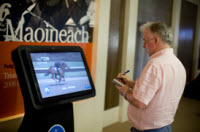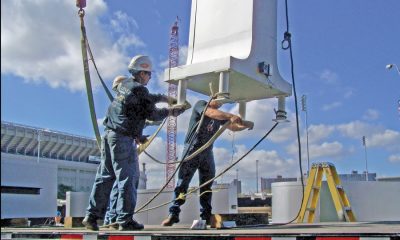News
The ImagePoint Crap Shoot: Chapter Seven Come Eleven
Quasi-defunct ImagePoint has filed for Chapter 11 status, but may be forced into Chapter 7.
Published
15 years agoon

The hearing for ImagePoint’s creditors as to status is slated for May 20. Three other related hearings will occur before then.
Three creditors were trying to force ImagePoint, the quasi-defunct, $53 million (according to www.indeed.com) sign company, into Chapter 7 bankruptcy, which means complete liquidation (although liquidation doesn’t automatically preclude Chapter 11 status). The day of the noon, April 10 deadline, ImagePoint filed for Chapter 11 protection, which would allow it to reorganize. U.S. Bankruptcy Judge Marcia Phillips Parsons has set a 9 a.m. May 20 hearing in U.S. Bankruptcy Court in Knoxville, which is “a chance for the U.S. bankruptcy trustee in charge, plus any creditors who wish to question ImagePoint representatives under oath, about the company’s actions, finances, property, reorganization plan or other issues.”
According to the April 25 Knoxville News-Sentinel newspaper, ImagePoint attorney Robert Bailey said Chapter 11 status would allow ImagePoint “to maximize the value of the assets it liquidates.” Although sources tell me that Chapter 7 seems inevitable, they also say Bailey “has handled some really big cases over the years.”
As is typical in bankruptcy cases, ImagePoint is trying to reduce the number of creditors to which it must mail notices. A May 11 hearing was set to seek reduction of the approximately 4,200 creditors.
Additionally, on May 11, a hearing will be held with regard to claims from General Motors, McDonald’s and John Deere with regard to money paid (analogous to a retainer) to insure a readily available stock of signs for future use.
In a fourth hearing, set for May 18, Principle USA, the new U.S. subsidiary of a U.K.-based sign company that comprises former ImagePoint employees, has filed a breach-of-contract claim against its former quasi-partner. The April 9 Knoxville News-Sentinel reported, “Principle claims that ImagePoint had agreed to manufacture signs that were to be installed for a Principle client on buildings in eight U.S. states. Principle alleges that ImagePoint produced the signs, but installed them improperly, and 10 signs fell off buildings.”
AdvertisementImagePoint reported to bankruptcy court that it netted $1,093,029 from a pool of an estimated 1,700 items in an April 8 auction conducted by Stopol Auctions in Florence, KY, site of a former ImagePoint manufacturing facility. Included were signs for at least 20 companies, including Honda, Chevrolet, Ford, Nissan, GM, McDonald’s, Dollar General, FedEx, Chrysler, General Tire, Firestone, Jeep, 7 Eleven, Dunkin Donuts, John Deere, Clayton Home and Arctic Cat, according to an unofficial, pre-auction listing on the AuctionZip website. Equipment available for auction included brakes, shears, welders, screenprinting equipment, thermoformers and various tools.
However, the day of the auction, several creditors, including McDonald’s, “secured a court agreement ordering signs and other goods that ImagePoint was producing for them to be held out of an auction set for today,” the April 8 Knoxville News-Sentinel reported. The next day, the newspaper reported, “Bridgestone claims ImagePoint reneged on an agreement to produce signs Bridgestone had ordered before ImagePoint ceased operations. When Bridgestone sent trucks to Florence to get the signs, some were missing and later showed up on the Stopol Auctions LLC website listed among items ImagePoint intended to sell.”
After the fact, the newspaper reported on April 11, “Scott Mihalic, the auctioneer, said a crowd of at least 400 people plus about 200 online bidders bought all but a handful of the 1,700 items. ‘I know one printer went to Mexico City,’ he said. Other items went to Canada, England and Australia.”
Pat Heitz, of Heitz Sign Co. (Madison, IN) learned about the auction two days prior. ImagePoint owed him approximately $7,000 for installation work. He ended up purchasing roughly 25 lots at the auction for less than $3,000. Many lots were conglomerations: a pallet, a shelf, a rack of materials.
“They really didn’t know what they were selling,” he observed. “I bought stuff other people didn’t want.”
Heitz ended up with boxes of hardware, routers, some Chrysler metal letters and non-illuminated panels, some parts for McDonald’s signs and some new, crated FedEx/Kinko’s signs, but nearly a month later, he still wasn’t quite sure of everything he’d obtained. Despite having acquired roughly five truckloads of items, he was “mad at himself for not buying more.”
AdvertisementAt the auction, Heitz met a representative from a company that pays subcontractors who’ve filed mechanic’s liens against end users. Detroit-based BBK, whose website (www.e-bbk.com) describes it as “an international advisory firm,” was hired by General Motors to handle claims from ImagePoint-related creditors. BBK has been offering creditors 50 cents on the dollar, and Heitz accepted a payment of approximately $1,500 for GM invoices totaling $3,000.
Virtually all of the companies who have received money for ImagePoint work this year have succeeded with the threat of mechanic’s liens filed against the end user. The specifics will vary by state, and the applicable state is where the work was performed.
An attorney explained these liens in general terms: “A subcontractor can place a mechanic’s lien on the property of the recipient of his work or materials (“the customer”) when the general contractor doesn’t pay the subcontractor. Ordinarily, the subcontractor couldn’t sue the customer, because the subcontractor has no contract with the customer. On the other hand, it wouldn’t be fair to let the subcontractor go unpaid. Because the subcontractor places a lien on the customer’s property without any contract or court trials, mechanic’s liens must be filed in a very short time, sometimes within 90 days of when the work was completed, and they must be filed carefully.”
(At the International Sign Assn.’s Sign Expo, a Discovery Seminar session entitled “Mechanic’s Lien and Bond Claim Seminar” was held April 16. The online description [www.signs.org] read: “Learn why sign manufacturers and installers should use the states’ Mechanic’s and Construction Lien and Bond laws to protect their accounts receivable and collect out-standing invoices in a timely manner.”)
BBK debuted as Bahadur & Assoc. in 1977. Ironically, the company website’s History section says, for that initial year, “The company begins helping troubled organizations [primarily non-automotive] resolve problems with their creditors.” Two decades later, BBK received the first of many GM Supplier of the Year awards.
Dennis Thomas, the installation and service manager for Godwin & Son Signs (Harlingen, TX), praised BBK: “They did exactly what they said they would do. They paid us 50 cents on the dollar for all our invoices.”
AdvertisementHe explained that most of Godwin’s work (totaling $35,000) was for face replacements (Buick, Chevrolet and Cadillac) necessitated by Hurricane Dolly last summer. Although the consensus on numerous message boards has been that only mechanic’s liens will coerce payments for service work, Thomas said Godwin hadn’t filed any. He said he had another invoice for work done for Honda, but the Jim Pattison Sign Group (which now has the account) asked him to forward the invoice, and they would pay it.
Second-generation signmaker Stephen Reese, who manages Valley Signs & Survey (Ooltewah, TN), admits his company made a big mistake by trusting more than 85% of its annual $350,000 in sales to ImagePoint. He’s been able to receive approximately $100,000 so far and is working on another $30,000 via the end users.
Reese has two tech people yet to re-hire; his pay scale has been reduced, and overtime has been eliminated. He and two partners may get paid “if there is money available,” but the company was able to nearly recover in eight weeks.
Subsequently, Reese said, “We have vowed in our business model not to allow any one company to have more than 30% of our entire business.” Additionally, he now tries to get 30% down and payment no later than 45 days. “There is plenty of work out there for us. We have turned down more work in the last 30 days than
I did in a year,” Reese wrote. “This is a good sign.”
Ironically, although Wachovia shut the door on ImagePoint, Reese said, “[Wachovia] was the only company to pay us 100% of what was owed for work done. We had completed numerous, full-installation packages of Wachovia Banks and custom manufacturing of product for both Wachovia Bank and Wachovia Securities, etc. They worked with us and were quite helpful and understanding to our situation.”
Reese said he received the bankruptcy hearing letter April 29 and will attend: “We have not filed liens yet but are in process with a few accounts that have larger debts/receivables [as of April 30].”
Valley Signs was working on eight ImagePoint programs when the company closed its doors, and it had worked with it and the predecessor, Plasti-Line, for 11 years. “We were a ‘core’ vendor, and our invoices were supposed to be paid in 30 days. This, of course, never happened, but they always paid [normally around 90 days],” Reese said. Although he had trouble with a few project managers, “the majority of the [ImagePoint] people were professional and courteous, and we were treated fairly.”
Several people told me BBK would soon be representing Chrysler as well, but, with both ImagePoint and Chrysler essentially bankrupt, collections may be trickier, one attorney told me.
We will post updates, as these hearings proceed, on www.signweb.com.

SPONSORED VIDEO
Introducing the Sign Industry Podcast
The Sign Industry Podcast is a platform for every sign person out there — from the old-timers who bent neon and hand-lettered boats to those venturing into new technologies — we want to get their stories out for everyone to hear. Come join us and listen to stories, learn tricks or techniques, and get insights of what’s to come. We are the world’s second oldest profession. The folks who started the world’s oldest profession needed a sign.
You may like

30 Snapshots of the 2024 ISA Sign Expo

Sign Products Wrap-Up for April

ISA Announces New Tradeshows and Meetings VP
Subscribe

Bulletins
Get the most important news and business ideas from Signs of the Times magazine's news bulletin.
Most Popular
-

 Tip Sheet1 week ago
Tip Sheet1 week agoAlways Brand Yourself and Wear Fewer Hats — Two of April’s Sign Tips
-

 Ask Signs of the Times3 days ago
Ask Signs of the Times3 days agoWhy Are Signs from Canva so Overloaded and Similar?
-

 Real Deal1 week ago
Real Deal1 week agoA Woman Sign Company Owner Confronts a Sexist Wholesaler
-

 Benchmarks5 days ago
Benchmarks5 days ago6 Sports Venue Signs Deserving a Standing Ovation
-

 Editor's Note2 weeks ago
Editor's Note2 weeks agoWhy We Still Need the Women in Signs Award
-

 Women in Signs1 week ago
Women in Signs1 week ago2024 Women in Signs: Megan Bradley
-

 Photo Gallery1 week ago
Photo Gallery1 week ago21 Larry Albright Plasma Globes, Crackle Tubes and More
-

 Women in Signs1 week ago
Women in Signs1 week ago2024 Women in Signs: Ashley Borell











